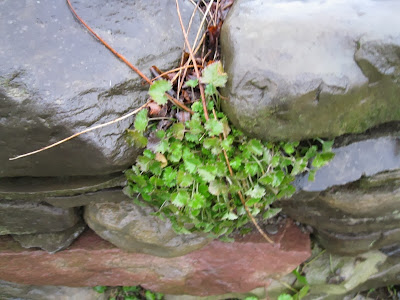Sunday, December 22, 2013
Late December Thaw
Recent frigid cold accompanied by generous amounts of snow are both unusual for this time of year. Today, daytime temperatures exceeded 62 degrees F and now the snow is all gone. Snow melt accompanied by rain has sent the river into fields. We found a break in the rain and ventured out to have a look at some of our plants.
Serbian Bellflower, Campanula poscharskyana is a vigorous plant that will find a foothold between wall stones. One of the top stones was lifted out and a handful of soil thrown on the base stones. Roots of a transplant were fanned out before the top stone was replaced. A sprinkling can of water during long periods of no rain was the only attention this plant needed. Next summer, long stems of lavender colored flowers will reach nearly to the ground. Now the plants seems to thrive under the snow. It looks like next season's growth is already underway. Clean wet stones look uncharacteristically bright today.
Clara Curtis chrysanthemums have proven hardy here. Their masses of pink flowers remind one of carnival cotton candy. These plants appear to be readying themselves for another great year. We must take time to pinch them back this summer to increase their blossom count and to keep them tidy.
Our transplanted Fringed Polygala is thriving inside of its wire cage. We learned the hard way that evergreen plants face destruction from hungry birds and animals during seasons when few plants are actively growing. Marauding crows very nearly destroyed this treasured wild flower during its first year in captivity. Protected by a wire cage, this plant is now sporting generous growth. We may have many tiny magenta orchids here for Mother's Day. The cage lifts off when we sit on the nearby wall to enjoy the flowers.
Bluets have long been favorites of Becky. We have failed several times to bring this plant into the garden. Our original transplants have vanished but new plants have now become common. Marine shellfish fossils are also common here. They remind us that this area was once covered by an inland sea. We were unaware that the fossils were formed as a result of a massive die off caused by a flood of sediment laden water that covered and suffocated wide areas of marine life.
This bright vigorous growth is one of our most hated weeds. Each tiny set of green leaves springs from a huge wide and deep mass of roots. Quantities of soil are removed with each pulled weed. If the stem breaks, then new minuscule growth will appear. That combination of tiny top growth and massive roots is nearly impossible to weed out intact. Weeding looked inviting today, but the cold soil would soon make for screaming hands. This area will get early attention come Spring. We would like to completely weed out this pest but will settle for buckets of weeds and soil to add to the compost pile.
Subscribe to:
Post Comments (Atom)





No comments:
Post a Comment